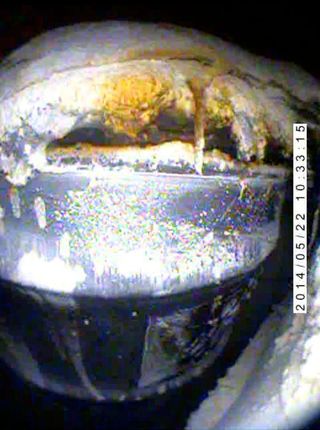Kitty Litter to Blame for Nuclear Waste Leak

If you're trying to stabilize nuclear waste, don't use organic kitty litter.
That's the take-away of a 277-page report, just released by the Department of Energy (DOE), on a radioactive leak that occurred at the underground Waste Isolation Pilot Plant (WIPP) east of Carlsbad, New Mexico, on Feb. 14, 2014.
Investigators confirmed that a 55-gallon metal drum of nuclear waste burst open after it was packed with the wrong kind of cat litter, as had been suspected since last year. [Nuclear Security: Best & Worst Countries (Infographic)]
Kitty litter isn't just used to absorb urine; it's long been used for industrial purposes, too. Traditional cat litter is usually made from inorganic silicates that can stabilize nitrate salts found in nuclear waste, James Conca explained in Forbes last year.
"Nitrate salt solutions can ignite when they dry out," Conca wrote. "So you need to stabilize nitrate solutions before they dry out, or prevent them from completely drying out."
When the drum in question was packed at Los Alamos National Laboratory, in New Mexico, it was filled with organic kitty litter called Swheat Scoop, which, as the name suggests, is primarily made with wheat. A report in the Santa Fe New Mexican last year suggested the mistake might have stemmed from a typo in Los Alamos' policy manual, which said to ensure "an organic absorbent (kitty litter)" was added to the waste when preparing drums of nitrate salt.
DOE officials concluded the contents of the drum were "chemically incompatible" and that gases built up over time, causing the lid to burst open after it was stored at WIPP.
Sign up for the Live Science daily newsletter now
Get the world’s most fascinating discoveries delivered straight to your inbox.
"Experiments showed that various combinations of nitrate salt, Swheat Scoop®, nitric acid and oxalate self-heat at temperatures below 100 degrees C (212 degrees Fahrenheit)," DOE officials wrote in a summary of the findings. "Computer modeling of thermal runaway was consistent with the observed 70-day birth-to-breach of Drum 68660."
No one was seriously hurt as a result of the accident, though 21 people were exposed to low-level radioactivity.
WIPP is used to store drums full of things like debris, protective gear and tools that have been contaminated with plutonium and other artificial radioactive elements created during nuclear weapons development. The facility is the nation's only permanent underground nuclear waste dump, located about a half-mile underground in geologically stable salt deposits.
But WIPP has been closed since the accident, and it might take more than a half-billion dollars to get the facility operational again, the Albuquerque Journal reported. However, U.S. Energy Secretary Ernest Moniz said this week that the dump could be back online in about a year.
Follow Megan Gannon on Twitter. Follow us @livescience, Facebook & Google+. Original article on Live Science.

